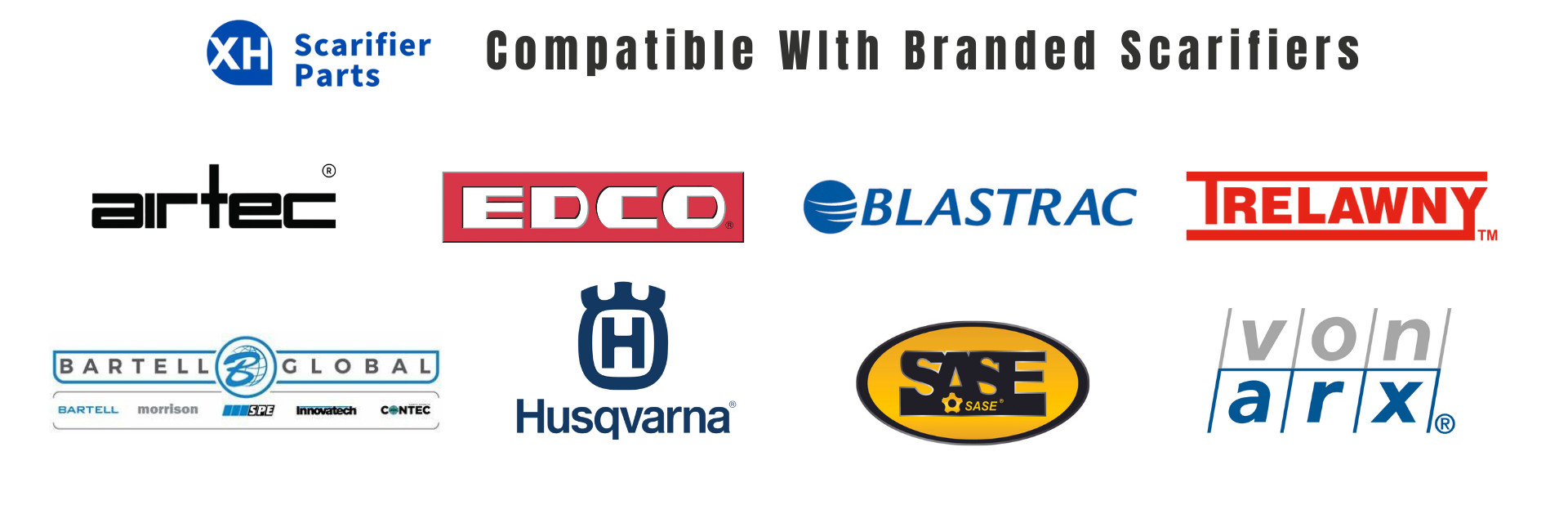Revolutionizing Surface Prep: Next-Gen Scarifiers Drums With TCT Carbide Cutters Dominate Industrial Flooring Renovation
2025-07-04
Revolutionizing Surface Prep: Next-Gen Scarifiers Drums With TCT Carbide Cutters Dominate Industrial Flooring Renovation
The industrial flooring renovation sector is witnessing a paradigm shift, driven by the relentless demand for faster project turnaround and tougher surface preparation challenges. Leading equipment manufacturers are responding with a new generation of scarifier drums featuring Tungsten Carbide Tipped (TCT) cutters, specifically engineered for extreme durability and precision profiling. These aren't just incremental upgrades; they represent a fundamental leap in tackling everything from thick epoxy coatings to heavily spalled concrete.
The TCT Carbide Advantage:
Beyond Standard Tools:Traditional scarifier cutters often falter under intense abrasion or when encountering unexpected embedded rebar or aggregate. TCT carbide, however, brings unparalleled hardness and wear resistance. This translates directly to:
Dramatically Extended Lifespan: Reducing costly downtime for cutter changes on large-scale projects like warehouses and factories.
Consistent Performance: Maintaining optimal cutting depth and surface profile throughout the job, critical for adhesion in coatings or overlays.
Reduced Vibration: Superior metallurgy and cutter design minimize chatter, enhancing operator comfort and machine longevity.
Cost Efficiency: Lower cost-per-square-foot despite higher initial tooling cost due to vastly superior longevity.
Industry Leaders Spearheading the Movement:
Bartell BEF 200 & BEF 320: Setting the standard for warehouse and heavy industrial prep. The BEF 200 excels in rapid material removal for leveling vast floorplates, while the BEF 320 tackles the toughest challenges – deep spalling repair and preparing severely damaged concrete for structural overlays. Their robust drum design ensures stability under maximum load.
Blastrac BMP-215 & BMP-335: Synonymous with heavy-duty coating removal. The BMP-215 is a workhorse for stripping thick epoxy, mastic, and paint in manufacturing plants. The larger BMP-335 takes this further, designed for continuous operation in large facility maintenance contracts, stripping coatings and profiling concrete simultaneously with exceptional efficiency.
Trelawny TFP 260: Engineered for high-performance grinding and profiling on demanding industrial floors. Its optimized cutter pattern delivers an exceptionally uniform CSP (Concrete Surface Profile) essential for high-build epoxy or urethane coatings, maximizing bond strength in critical environments.
Beyond the Warehouse: Specialized Applications Rise
The versatility of modern TCT drums extends far beyond standard concrete prep:
Edco CPM-8: Gaining traction in parking garage restoration, efficiently removing delaminated concrete, coatings, and creating the ideal profile for waterproofing membranes and new toppings, combating corrosion in multi-level structures.
Dr. Schulze DBF200: Uniquely designed for steel surface profiling. Essential for shipyards, offshore platforms, and structural steel refurbishment, it prepares metal surfaces for high-performance coatings by creating the crucial anchor pattern (SA ratings) without warping thin metal.
Grost SM-200: Focused on the booming polished concrete market. It provides the critical initial coarse grinding step efficiently, removing coatings, leveling minor inconsistencies, and opening the concrete surface for subsequent polishing stages, saving significant time.
The Future is Carbide-Tipped: As industrial flooring systems become more complex and performance demands increase, the reliance on TCT carbide scarifier drums like the Bartell BEF series, Blastrac BMPs, Trelawny TFP, and specialized tools from Edco, Dr. Schulze, and Grost is becoming the industry standard. The combination of brute force, precision profiling, and unmatched durability makes them indispensable tools for contractors facing tight deadlines and demanding specifications.
View More
Scarifying Machines Drum Setup With Tungsten TCT Carbide Cutters
2025-04-10
Scarifying Machines Drum Setup With Tungsten TCT Carbide Cutters:
Maximizing ROI for Rental Companies and Distributors
For construction equipment rental companies and distributors, offering scarifying machines with versatile drum setups can be a game-changer. By understanding the different cutter types and their applications, you can cater to a wider range of customer needs, from industrial flooring to road maintenance. Here’s how to optimize your drum setup to maximize ROI and customer satisfaction.
Top Cutter Materials & Their Advantages
- Tungsten Carbide (TCT): Resists heat and abrasion, ideal for high-traffic concrete grinding.
- Hardened Steel (Star/Beam Cutters): Balances aggressiveness and substrate protection.
- Steel Milling Heads: Delivers smooth finishes for specialized tasks like road marking removal.
Critical Applications Across Industries
1. Construction Equipment Rental Companies: Stock machines with interchangeable cutters to cater to diverse client needs, from parking garage renovations to steel surface prep.
2. Contractors: Use TCT cutters for heavy-duty tasks or Beam cutters for delicate surfaces to minimize substrate damage.
3. Distributors: Highlight cross-brand compatibility to reduce inventory costs and increase customer loyalty.
- Cost-Saving Tip: Reduce equipment downtime by using interchangeable cutters across Smith, Graco, or Edco machines.
- Performance Insight: Milling cutters increase efficiency by 30% on tacky material removal versus standard blades.
Final Note: Investing in versatile, high-quality cutters ensures repeat business from contractors who value adaptability and reliability. Check compatibility charts to confirm fitment with your scarifier models and always keep a variety of cutters in stock to meet diverse customer demands.
#contractors #equipmentrental #Bestscarifiercuttersforconcrete #Howtosetupscarifierdrum #scarifyingmachinesdrumsetup #surfacepreparationtools #Scarifyingmachinesdrumsetup
View More
How to Choose Tools for Your Surface Preparation: Scarifier Milling Cutters vs. Scarifier Carbide TCT Cutters
2025-04-22
Surface preparation is a critical step in construction, road maintenance, and industrial projects, impacting the longevity and performance of materials like concrete, asphalt, and steel. Choosing the right tool—whether Scarifier milling cutters or Scarifier carbide TCT (tungsten carbide-tipped) cutters—can make or break your project’s efficiency, cost, and quality. This guide dives into the key factors to consider, tailored for contractors, equipment distributors, and rental companies navigating applications like Road Scarifying, Line Removal, Rust Removal, and Concrete Prep.
1. Understanding the Tools: Scarifier Milling Cutters vs. TCT Cutters
Scarifier Milling Cutters
Heavy-duty tasks requiring rapid material removal (e.g., asphalt milling, Barn Grooving).
Applications where surface smoothness is secondary to speed.
Budget-conscious projects due to lower initial tooling costs.
Scarifier Carbide TCT Cutters
Precision work requiring clean, controlled cuts (e.g., LineStriping, DeckScarifiers).
Long-term projects where tool longevity offsets higher upfront costs.
Harsh environments (e.g., Rust Removal on steel decks or Asfalto milling).
2. Key Factors to Consider When Choosing Tools
Concrete/Asphalt: For dense concrete (Cemento) or aged asphalt (Asfalto), TCT cutters outperform milling cutters due to their ability to maintain sharpness under stress. They are also preferred for #PreparazioneSuperfici in decorative concrete work.
Softer Surfaces: Milling cutters with flail teeth (FlailCutter) are cost-effective for softer materials like loose asphalt or light coatings.
Project Scale and Duration
Milling Cutters: Lower initial cost but higher maintenance due to frequent tooth replacements. Ideal for contractors prioritizing upfront savings.
TCT Cutters: Higher initial investment but 70% longer lifespan, reducing downtime and #ScarifierSpareParts needs. For example, BENTELER’s SMARTCUT® technology cuts CO2 emissions by 75% while enhancing tool efficiency.
For smooth finishes (e.g., FloorSandingMachines or BlastracBMP265 applications), TCT cutters provide finer control.
Rough surfaces (e.g., Irruvidimento for anti-slip textures) can tolerate the coarser finish of milling cutters.
3. The Role of Drum Setup and Tool Configuration
Multi-Purpose Drums: Combine flail cutters for heavy demolition and TCT tips for precision grooving (Grooving).
Specialized Drums: Use dedicated TCT drums for #VonarxVA30 applications in dairy farming (DairyFarming) to avoid cross-contamination.
Rental companies (RentalCompanies) are pivotal for contractors needing flexibility. For instance:
Milling Cutters: Regularly inspect teeth for wear and replace damaged flails to prevent uneven surfaces.
TCT Cutters: Clean carbide tips after use to prevent debris buildup, extending their lifespan by up to 400%
Sustainability: TCT tools align with green initiatives (e.g., EU’s Green Deal) due to lower CO2 emissions and recyclable materials
Conclusion: Matching Tools to Your Needs
#SurfacePrep #CarbideCutter #ScarifierCarbideTCT #RoadScarifiers #EquipmentDistributors #Rent #Scarificatrici #ConcretePrep #LineSriping #Vonarx #BlastracBMP265 #DeckScarifiers #AirtecRM320 #BarnGrooving #ConstructionEquipmentRental #RoadMaintenance #SurfacePreparationTools #ScarifyingMachines #ConstructionEquipmentRental #Contractors #RoadConstruction
View More
Concrete Scarifiers Carbide TCT Cutters For Surface Preparation and Levelling Applications
2025-04-07
Concrete Scarifiers Carbide TCT Cutters For Surface Preparation and Levelling Applications
Scarifiers and planers are critical for removing old coatings (e.g., paint, epoxy, mastics), adhesives, or contaminants from concrete floors. This ensures proper adhesion for new coatings or overlays.
Scarifiers use rotating cutting tools (e.g., TCT cutters, star cutters) to aggressively strip surfaces. For example, Smith Manufacturing lists scarifiers as a core product for surface preparation, emphasizing their role in heavy-duty material removal.
Planers focus on precision leveling, ideal for smoothing uneven surfaces or removing thin layers of concrete.
These machines are employed to address spalling, cracks, or unevenness in concrete floors.
Floor planers excel at creating a smooth substrate by removing high spots or imperfections, often in preparation for polished concrete or flooring installations.
Beam cutters (a type of scarifier tooling) minimize substrate damage while removing light corrosion or paint, preserving structural integrity.
Texturing and Profiling
Construction sites: Preparing floors for epoxy coatings, tile installations, or waterproofing.
Roadwork: Removing road markings or leveling asphalt/concrete pavements.
Warehouses and factories: Maintaining smooth, safe flooring for machinery and workflows.
TCT (Tungsten Carbide Tipped) cutters: Standard for general-purpose scarifying due to durability.
Beam cutters: Ideal for light paint/corrosion removal with minimal substrate damage
Star cutters: Optimized for rubberized coatings but wear faster due to pointed edges.
View More
Maximize Efficiency with Scarifiers Carbide Tungsten TCT Cutters for Concrete Scarifying
2025-03-27
Maximize Efficiency with Scarifiers Carbide Tungsten TCT Cutters for Concrete Scarifying
Why Choose TCT Cutters for Concrete Scarifying?
When it comes to concrete scarifying, surface preparation, and coating removal, the right scarifier cutters can significantly impact performance. Scarifiers carbide tungsten (TCT) cutters are the industry standard for durability, efficiency, and versatility.
Key Benefits of TCT Cutters for Scarifiers
• Superior Durability – Made from tungsten carbide tips (TCT), these cutters withstand tough concrete, epoxy, and other hard surfaces.
• Wide Compatibility – Works with major brands like Husqvarna, EDCO, Blastrac, Scanmaskin, SASE, and more.
• Consistent Performance – Ideal for concrete levelling, texturing, and coating removal without excessive wear.
• Cost-Effective – Longer lifespan reduces downtime and replacement costs.
Applications of TCT Cutters
• Concrete surface preparation before coatings
• Removing thick epoxy, paint, and mastics
• Levelling uneven concrete floors
• Restoring traction on polished surfaces
Compatible Scarifier Brands
These carbide tungsten cutters fit machines from EDCO, Blastrac, Husqvarna, Scanmaskin, SASE, Smith, Graco, Von Arx, and other leading manufacturers.
For distributors, OEMs, and service providers, stocking high-quality TCT cutters for scarifiers ensures customers get the best results in industrial and construction projects.
#concretesurfaceprep #surfacepreparation #scarifiers #scarifiercarbidetct #scarifying
View More







